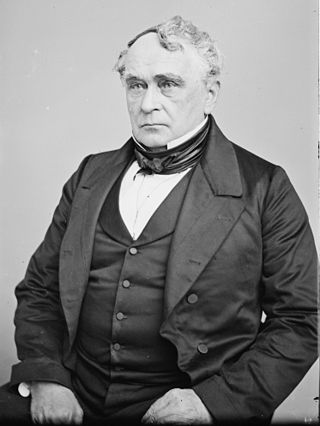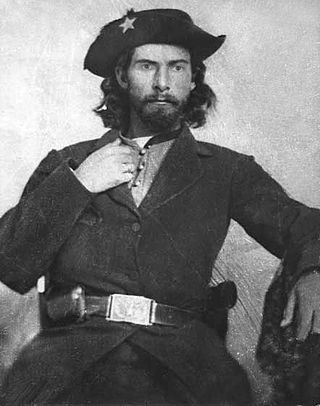
The Confederate States Army, also called the Confederate Army or the Southern Army, was the military land force of the Confederate States of America during the American Civil War (1861–1865), fighting against the United States forces to win the independence of the Southern states and uphold and expand the institution of slavery. On February 28, 1861, the Provisional Confederate Congress established a provisional volunteer army and gave control over military operations and authority for mustering state forces and volunteers to the newly chosen Confederate States president, Jefferson Davis (1808-1889). Davis was a graduate of the United States Military Academy, on the Hudson River at West Point, New York, and colonel of a volunteer regiment during the Mexican–American War (1846-1848). He had also been a United States senator from Mississippi and served as U.S. Secretary of War under 14th President Franklin Pierce. On March 1, 1861, on behalf of the new Confederate States government, Davis assumed control of the military situation at Charleston Harbor in Charleston, South Carolina, where South Carolina state militia had besieged the longtime Federal Fort Sumter in Charleston harbor, held by a small U.S. Army garrison under the command of Major Robert Anderson (1805-1871). By March 1861, the Provisional Congress of the Confederate States meeting in the temporary capital of Montgomery, Alabama, expanded the provisional military forces and established a more permanent regular Confederate States Army.

United States Colored Troops (USCT) were Union Army regiments during the American Civil War that primarily comprised African Americans, with soldiers from other ethnic groups also serving in USCT units. Established in response to a demand for more units from Union Army commanders, USCT regiments, which numbered 175 in total by the end of the war in 1865, constituted about one-tenth of the manpower of the army, according to historian Kelly Mezurek, author of For Their Own Cause: The 27th United States Colored Troops. "They served in infantry, artillery, and cavalry." Approximately 20 percent of USCT soldiers were killed in action or died of disease and other causes, a rate about 35 percent higher than that of white Union troops. Numerous USCT soldiers fought with distinction, with 16 receiving the Medal of Honor. The USCT regiments were precursors to the Buffalo Soldier units which fought in the American Indian Wars.

During the American Civil War, the United States Army, the land force that fought to preserve the collective Union of the states, was often referred to as the Union army, the federal army, or the northern army. It proved essential to the restoration and preservation of the United States as a working, viable republic.

In the American Civil War (1861–65), the border states or the Border South were four, later five, slave states in the Upper South that primarily supported the Union. They were Delaware, Maryland, Kentucky, and Missouri, and after 1863, the new state of West Virginia. To their north they bordered free states of the Union, and all but Delaware bordered slave states of the Confederacy to their south.

Quantrill's Raiders were the best-known of the pro-Confederate partisan guerrillas who fought in the American Civil War. Their leader was William Quantrill and they included Jesse James and his brother Frank.

The Lieber Code was the military law that governed the wartime conduct of the Union Army by defining and describing command responsibility for war crimes and crimes against humanity; and the military responsibilities of the Union soldier fighting in the American Civil War against the Confederate States of America.

The Confederate States Congress was both the provisional and permanent legislative assembly / legislature of the Confederate States of America that existed from February 1861 to April / June 1865, during the American Civil War. Its actions were, for the most part, concerned with measures to establish a new national government for the Southern proto-state in the current Southern United States region, and to prosecute a war that had to be sustained throughout the existence of the Confederacy. At first, it met as a provisional congress both in the first capital city of Montgomery, Alabama, and the second in Richmond, Virginia. As was the case for the provisional Congress after it moved northeast to Richmond, the permanent Congress met in the existing Virginia State Capitol, a building which it also shared with the secessionist Virginia General Assembly.

The American Civil War saw extensive use of horse-mounted soldiers on both sides of the conflict. They were vital to both the Union Army and Confederate Army for conducting reconnaissance missions to locate the enemy and determine their strength and movement, and for screening friendly units from being discovered by the enemy's reconnaissance efforts. Other missions carried out by cavalry included raiding behind enemy lines, escorting senior officers, and carrying messages.

The U.S. state of West Virginia was formed out of western Virginia and added to the Union as a direct result of the American Civil War, in which it became the only modern state to have declared its independence from the Confederacy. In the summer of 1861, Union troops, which included a number of newly formed Western Virginia regiments, under General George McClellan drove off Confederate troops under General Robert E. Lee at the Battle of Philippi in Barbour County. This essentially freed Unionists in the northwestern counties of Virginia to form a functioning government of their own as a result of the Wheeling Convention. Before the admission of West Virginia as a state, the government in Wheeling formally claimed jurisdiction over all of Virginia, although from its creation it was firmly committed to the formation of a separate state.

Bushwhacking was a form of guerrilla warfare common during the American Revolutionary War, War of 1812, American Civil War and other conflicts in which there were large areas of contested land and few governmental resources to control these tracts. This was particularly prevalent in rural areas during the Civil War where there were sharp divisions between those favoring the Union and Confederacy in the conflict. The perpetrators of the attacks were called bushwhackers. The term "bushwhacking" is still in use today to describe ambushes done with the aim of attrition.

McNeill's Rangers was an independent Confederate military force commissioned under the Partisan Ranger Act (1862) by the Confederate Congress during the American Civil War. The 210 man unit was formed from Company E of the 18th Virginia Cavalry and the First Virginia Partisan Rangers. After the repeal of the Act on February 17, 1864, McNeill's Rangers was one of two partisan forces allowed to continue operation, the other being 43rd Battalion Virginia Cavalry. Both of these guerrilla forces operated in the western counties of Virginia and West Virginia. The Rangers were known to exercise military discipline when conducting raids. However, many Union generals considered Captain John Hanson McNeill (1815–1864) and his men to be "bushwhackers," not entitled to protection when captured, as was the case with other prisoners of war.

The 43rd Virginia Cavalry Battalion, also known as 43rd Virginia Rangers, Mosby's Rangers, Mosby's Raiders, or Mosby's Men, was a battalion of partisan cavalry in the Confederate Army during the American Civil War. Noted for their lightning strike raids on Union targets and their ability to consistently elude pursuit, the Rangers disrupted Union communications and supply lines.

The general officers of the Confederate States Army (CSA) were the senior military leaders of the Confederate States of America during the American Civil War of 1861–1865. They were often former officers from the United States Army before the Civil War, while others were given the rank based on merit or when necessity demanded. Most Confederate generals needed confirmation from the Confederate States Congress, much like prospective generals in the modern U.S. armed forces.

Guerrilla warfare was waged during the American Civil War (1861–1865) by both sides of the conflict, but most notoriously by the Confederacy. It gathered in intensity as the war dragged.

The military forces of the Confederate States, also known as Confederate forces or the Confederate Armed Forces and Confederate States Armed Forces, were the military services responsible for the defense of the Confederacy during its existence (1861–1865).

John Hanson "Hanse" McNeill was a Confederate soldier who served as a captain in the Confederate Army during the American Civil War. He led McNeill's Rangers, an independent irregular Confederate military company commissioned under the Partisan Ranger Act.
The 53rd Alabama Cavalry Regiment, also known as the 53rd Alabama Partisan Rangers, was a cavalry regiment that served in the Confederate Army during the American Civil War.
On June 20, 1863, the U.S. government created a new state from 50 western counties of Virginia to be named "West Virginia". This was done on behalf of a Unionist government in Wheeling, Virginia, approved by Congress and President Lincoln, though it was done with a low participation of the citizens within the new state. There remained a large number of counties and citizens who still considered themselves as part of Virginia and the Confederacy which, in turn, considered the new state as part of Virginia and the Confederacy. In 1861 the 50 counties contained a population of 355,544 whites, 2,782 freemen, 18,371 slaves, 79,515 voters and 67,721 men of military age. West Virginia was the 6th most contested state during the war, with 632 battles, engagements, actions and skirmishes.
The 56th Alabama Cavalry was a Confederate Partisan Ranger cavalry regiment from Alabama. Initially organized as 2 separate Partisan Ranger battalions, the 56th Regiment was created in the summer of 1863 and took part in several campaigns of the Western Theater of the American Civil War before surrendering in the spring of 1865.
The 1st Mississippi Partisan Rangers was a unit of the Confederate Army from Mississippi. The 1st Partisans operated as a cavalry regiment in North Mississippi and Tennessee, but suffered serious setbacks in late 1862 that compromised its effectiveness as a unit. Reorganized as the 7th Mississippi Cavalry Regiment in 1864, the regiment surrendered at the close of the war in May, 1865.
















